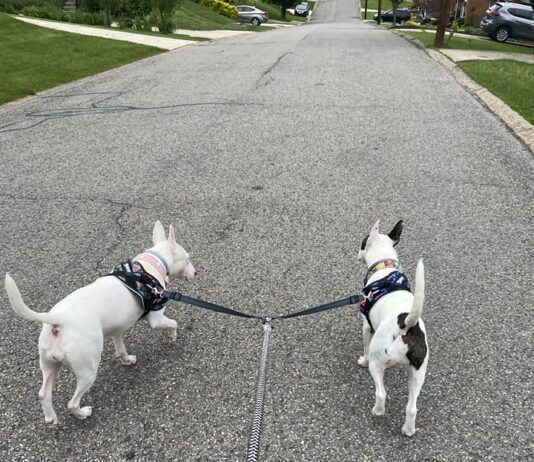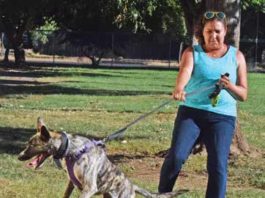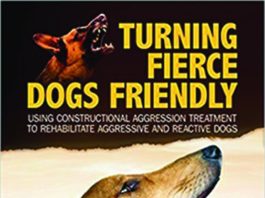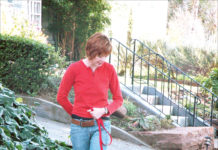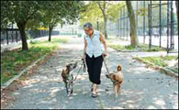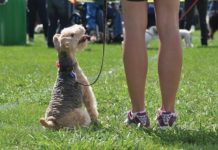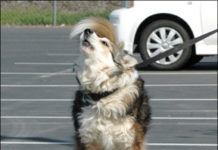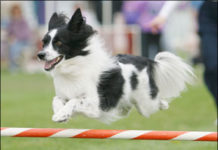Do Electric Shock Collars Harm Dogs?
Do you use an underground electric shock fence to contain your dog? Are you considering having one installed? I hope reading this will change your mind. More and more neighborhoods prohibit or limit the useof fencing, and as this occurs, the use of these non-visible electric shock perimeters has drastically increased. Manufacturers and retailers claim that these products are humane, effective means by which to safely confine dogs without disrupting the aesthetics of neighborhoods.
How to Help a Leash-Reactive Dog
Beyond the human hang-ups and logistical challenges associated with a dog who now displays reactive behavior in the presence of other dogs, we must consider the impact on the dog. Reactive outbursts are the product of distress, and distress is serious business. It takes a long time for the body to recover from the jolt of hormones that happens during a distressful event. This altered brain state can leave your dog susceptible to triggers he might not otherwise react to, which is why many dogs can seem edgy" for some time following a particularly stressful event."
Why (and How) Dogs Escape Fences
The risks for a free-roaming dog are legion, including, but not limited to: getting hit by a car, shot by an irate neighbor or a police officer protecting public safety, attacking or being attacked by other animals, being picked up by animal control, or simply vanishing, never to be seen again. Yet some dogs seem hell-bent on escaping doing everything they can think of to get over, under, around, or through their humans' containment strategies. What do you do when you have a dog who is dedicated to escaping his yard?
Why We Don’t Recommend Electric Fences (Shock Collars)
this makes many of them associate whatever they saw that drew them toward the boundary other dogs
Tips on Stopping a Loose Dog from Approaching You
Being approached by loose dogs, especially when my dogs are on leash, is my least-favorite experience as a dog owner. When we're walking in a public place, such as a beach or park, I can usually identify the owner and ask that he please wrangle his dog. Of course, this request may be met with varying responses, ranging from appropriately apologetic for their dog having invaded our space, to accusatory, suggesting I am the problem for not allowing my dogs to roam free and socialize. But as uncomfortable as it may be to deal with unpleasant dog owners, it can be even worse to deal with a loose dog whose owner is nowhere in sight!
9 Expert Tips for Walking Your Own Dogs
Use good equipment that is appropriate for your dog (for example, if not well trained, giant dogs probably need more than a flat collar and retractable leashes are not considered safe, ever). Inspect the fit and condition of all your equipment frequently. Ensure that your dog wears a tag with current information.
Some Quick Tips for Loose Leash Walking
Joan Morse, CPDT-KA, CA-P1, CNWI, of Tailwaggers Canine Campus in Newark, Delaware, recommends Leslie McDevitt’s “Pattern Games” when teaching loose-leash walking. She describes one of those games: “The Two Step: drop a treat on the ground. Take two steps forward while the dog eats the treat. The moment he looks up at you, click, drop another treat right by you and take two more steps. This game develops a pattern or rhythm for the dog that will keep his attention on the handler and keep him moving as she moves. You usually get a nice loose leash walk quickly.”
Leash Reactivity in Otherwise Friendly Dogs
If you hang around with other dog owners, you've no doubt heard the same comment I have, over and over again: My dog is fine with other dogs when he's off-leash; he's only dog-aggressive when his leash is on." You may have even said it yourself. The reason it's an often-heard comment is that it's a common behavior: A lot of dogs who are fine with other dogs when left to their own devices become aggressive if they are leashed when they meet other dogs."
Counter-Conditioning and Desensitization for Reducing Dog Reactvity
Counter-conditioning involves changing your dog’s association with a scary or arousing stimulus from negative to positive. Desensitization is starting with a very low-level intensity of aversive stimulus until the dog habituates to (or changes his association with) the aversive, and then gradually increasing the strength until the dog is comfortable with the stimulus at full intensity. The easiest way to give most dogs a positive association and to help them become comfortable with a stimulus is with very high-value, really yummy treats. I like to use chicken – canned, baked, or boiled; most dogs love chicken. Here’s how the CC&D process works.
Unwanted Dog-Reactive Behaviors
Dog-reactive behavior can be alarming and frustrating for a dog owner, as well as damaging to the canine-human relationship. Most of us adopt our dogs with the hope of sharing them with the rest of the world – on walks, at family picnics, at events around town, and sometimes at canine competitions. It’s not quite as much fun when you have to leave your canine family member at home because he barks, leaps around, lunges at, maybe even tries to bite other dogs.
Installing Safe and Affordable Fencing for Dogs
There was a time when no one thought twice about letting their dogs roam the neighborhood. A fenced yard was almost unheard of. If you grew up in the 1950s and '60s as I did, you may remember those times. Dogs were well socialized, loved kids, and it was no big deal when the neighbor's dog came over and visited your female dog in season. Of course, they also chased cars, got pregnant a lot, and occasionally although rarely bit someone. You may also remember, as I do, a long list of childhood pets who got shot, hit by cars, or simply vanished, having fallen victim to who knows what fate. Today, our canine companions are more likely to be spayed or neutered, vaccinated, and responsibly contained. As a result, they tend to live safer, longer lives. But having a fence isn't always the be-all, end-all solution that it seems to be. Fences can bring on a host of challenges that our parents never faced with the family dog a generation ago.
Solutions for Reactive Dog Behavior
At some point in our lives, some of us find ourselves living with a difficult dog, one whose behavior challenges our patience, and exhausts our training knowledge – and opens our hearts and eyes to a new, better way of training. This is the story of one such dog and her very knowledgeable dog owner. Together, they reached an entirely new and higher level of dog training skills, thanks to the owner’s life-altering experiences with a reactive dog who wasn’t fit to compete in the career intended for her: Flyball. Flyball is not the sport for everyone. It is a relay team event, which means you have to commit to training and competing with your dog and other dogs and dog owners as a team, and you have to have an appreciation for over-the-top dogs and the resulting cacophony of sounds. In flyball, a team of four dogs race, one after the other, leaping a series of hurdles, throwing their bodies against a spring-loaded box that ejects a tennis ball, snatching the ball, and hurtling their bodies back down the row of jumps to where their next teammates strain to be released for their turns. The fastest team wins.


